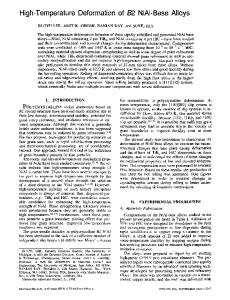High temperature plastic deformation of two V-Ga alloys with A15 structure
- PDF / 1,931,012 Bytes
- 7 Pages / 594 x 774 pts Page_size
- 5 Downloads / 317 Views
I.
INTRODUCTION
THE superconducting AI5 compounds are quite brittle under conditions of ambient temperature and pressure, and few systematic studies of their plasticity have been undertaken. Plastic deformation has been observed above homolcrystal "stu~lies'of-V3si have note~l {100}(010)slip I~ehavior, TM and dislocations with cube direction Burgers vectors have been observed.S The hot deformed microstructures contain polygonized dislocations.6'7 Polycrystalline ductility is observed despite the fact that there are only three independent {100} (010) slip systems. The stress-strain rate relations of plastically deforming Nb3Sn are largely those of power law creep with an activation energy for creep of 400 to 500 kJ/mol. 1.8Refined grain size increases the flow stress, while lowering the ductile-tobrittle transition temperature) The ductile-to-brittle transition temperature of AI5 cornpounds is greatly lowered by hydrostatic pressure. Nb3Sn, V3Si, and V3Ga polycrystals have been deformed at room temperature under hydrostatic pressures in the range from 1790 to 6000 MPa. 9-'3 For the case of V3Ga, Martynov, et al. 9 achieved a strain of 28 pct in compression with a hydrostatic pressure ambient of 1790 MPa, and Konyayev, et al. ~3 achieved single pass reductions of 30 to 40 pct in hydrostatic extrusion at a pressure of 2000 MPa. It has been suggested that commercial production of superconductors may eventually involve deformation processing at practical combinations of elevated temperature and hydrostatic pressure. 14 The very limited understanding of A 15 plasticity has motivated the present study of the hot deformation of V3Ga. Besides affording a comparison to the previous work on Nb3Sn and V3Si, this work allows a comparison of two different compositions in the rather wide compositional range of the nominal V3Ga structure. A V-Ga phase diagram is shown in Figure 1. GREGORY B. SOSCIA is with Wharton Business School, Philadelphia, PA 19104. ROGER N. WRIGHT is Professor and Acting Chairman, Materials Engineering Department, Rensselaer Polytechnic Institute, Troy, NY 12181. Manuscript submitted August 26, 1985.
METALLURGICAL TRANSACTIONS A
II.
MATERIAL PREPARATION AND CHARACTERIZATION
The procedure for preparing V3Ga polycrystals was based largely on the methods of Das, et a/. 15'17Alloys containing nominally 18 and 23 at. pct Ga were arc melted from V 0.3 cm slabs. The arc melting and casting were performed by Materials Research Corporation, Orangeburg, New York. The 99.99 pet pure Ga was obtained from Lieco Industries, Inc., New York, New York, and the 99.7 pct pure V turnings were obtained from Shieldalloy Corporation, Newfield, New Jersey. The V-18 Ga alloy lies at the V-rich limit of the AI5 phase field shown in Figure 1. The V-23 Ga is near the center of the field. Despite repeated efforts,
20OO|
1900~-~---_~ . , .
I
I
I
I
I
V3Ga
1 I
~ 1 "~ ~.'~t l[ 1 hd
~_
GALLIUM(oi-%) Fig. 1 - - V - G a phase diagram reported by van Vucht, et al.~5
VOLUME 17A, MARCH 1986--519
a composition near the Ga-rich
Data Loading...











